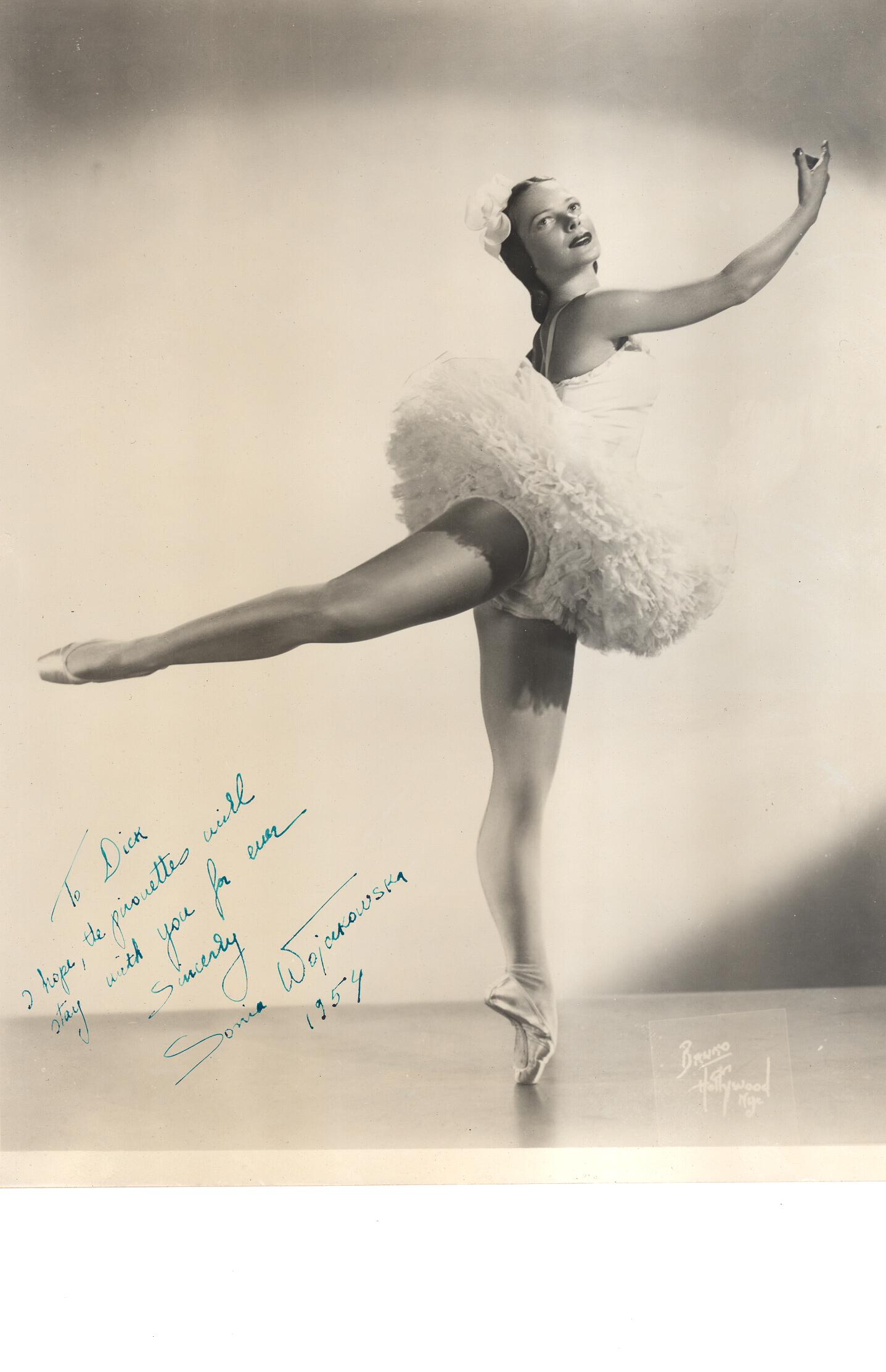Sonia Wojcikowska (b. 1919)

When I came to New York City in 1949 to continue my ballet studies at Ballet Arts, "Studio 61" at Carnegie Hall, I was surprised to see a very pregnant young lady spinning like a top. I asked a friend, "Who is that?" and was told she was Sonia Wojcikowska. I also found out that she was a teacher at the school. After the birth of her first baby she became one of my teachers and my friend. This friendship has lasted for almost fifty years.
1949 was a very special year for Sonia. It was the year that she became an American citizen, married violinist Joska de Barbary, and became pregnant with her first child.
Sonia was born in London December 17, 1919 of a Polish father, Leon Wozikowsky (he preferred this spelling), and Russian mother, Helene Antonova. She was educated at the Lycée Jules Ferrier, and studied ballet with Lubov Egorova in Paris, with her father, the famous character dancer of the renowned Diaghilev's Ballets Russes, and with Vilzak-Shollar in New York. She really learned her art by doing; she said, "I watched, I listened, I imitated."
Recently I was invited to her apartment to look at her photographs. There were pictures of her and the company of Diaghilev's Ballets Russes on the beach in Monte Carlo. Also there were photos on the ship that had taken her father's company, Leon Wozikowsky's Ballet Russe (the second company of de Basil's Ballet Russe), to Australia in 1936. Igor Youskevitch was also a member of this company. Sonia opened a metal box to show me her birth certificate and baptismal record, signed by her Godfather, Pablo Picasso.
Dancing in her father's company, she remembered with pride that in one ballet she wore a mask and danced in her father place. A friend of Leon said to him, "You danced better tonight than ever, but you look so short."
Sonia started her professional career as a little girl with a walk-on part in Diaghilev's Ballets Russes production of Petrouchka, holding the hand of Enrico Cecchetti.
She never had the option to become anything but a dancer, although in reality she would have preferred to be a singer. Sonia studied voice seriously, and at the age of nine sang the part of Chaliapin's granddaughter in the opera La Sirene (The Mermaid) at the Paris Opera. Later, at the request of Leonide Massine, she sang two Spanish songs offstage in his Three Cornered Hat. When Sonia was thirteen she danced with her mother at the Paris Opera with Les Ballets Ida Rubinstein. Sonia danced many of her mother's roles. (Her father told her once that he could not tell them apart.) By replacing Nathalie Krassovska in Rubinstein's company Sonia danced her first solo in Mikhail Fokine's Diane de Poitiers.
She joined Mme. Egorova's Ballet de la Jeunesse when she was 14 years old and was then invited to join her father's company, Leon Wozikowsky's Ballet Russe. She became a soloist with the Original Ballet Russe in 1938, and danced the roles of Frivolity (Les Présages), Can Can (Boutique Fantasque), and the Waltz (Les Sylphides). In 1939 she joined the Polish Ballet at the New York World's Fair and performed with them in France, Germany and Poland. Sonia also performed in a short concert tour with Yurek Shabelevsky in the USA.
In 1940 she became a soloist with Ballet Theatre (now American Ballet Theatre). She was often called on to fill in for an injured dancer. She makes fun of herself telling of times that she didn't always do the variation as choreographed. Once she went on for Lucia Chase in Les Syphides and after the performance her mother told her, "I never saw Lucia dance so poorly." She joined Ballet Russe de Monte Carlo and remained for three years. During World War II she gave many USO performances in camps and hospitals. After a few seasons in the musical Oklahoma, dancing the part of the "girl who falls down," she became ballerina of the Foxhole Ballet (1946-47), a small touring company. My good friend Richard Thomas was also part of this group.
Sonia's abilities as a teacher equaled her skill as a dancer. When Leon Wozikowsky needed a combination for class he would come to his daughter and ask for her help. Sonia's ability to put steps together is one of her great talents. During class her father would say, "Sonia, show us that combination I gave you this morning." Because of Sonia's respect for her father, she did as she was told. She considers French to be her first language, although she speaks at least five different languages.
Except for the time she took to have a second child, Sonia taught at Ballet Arts until she retired in 1975.
Leaving her apartment, the one impression that stood out in my mind was her response when I said, "Sonia, I know it was every day living to you, but you were there while dance history was being made." Her answer surprised me, "Funny, all I remember is the hunger."
(First published August 1997)